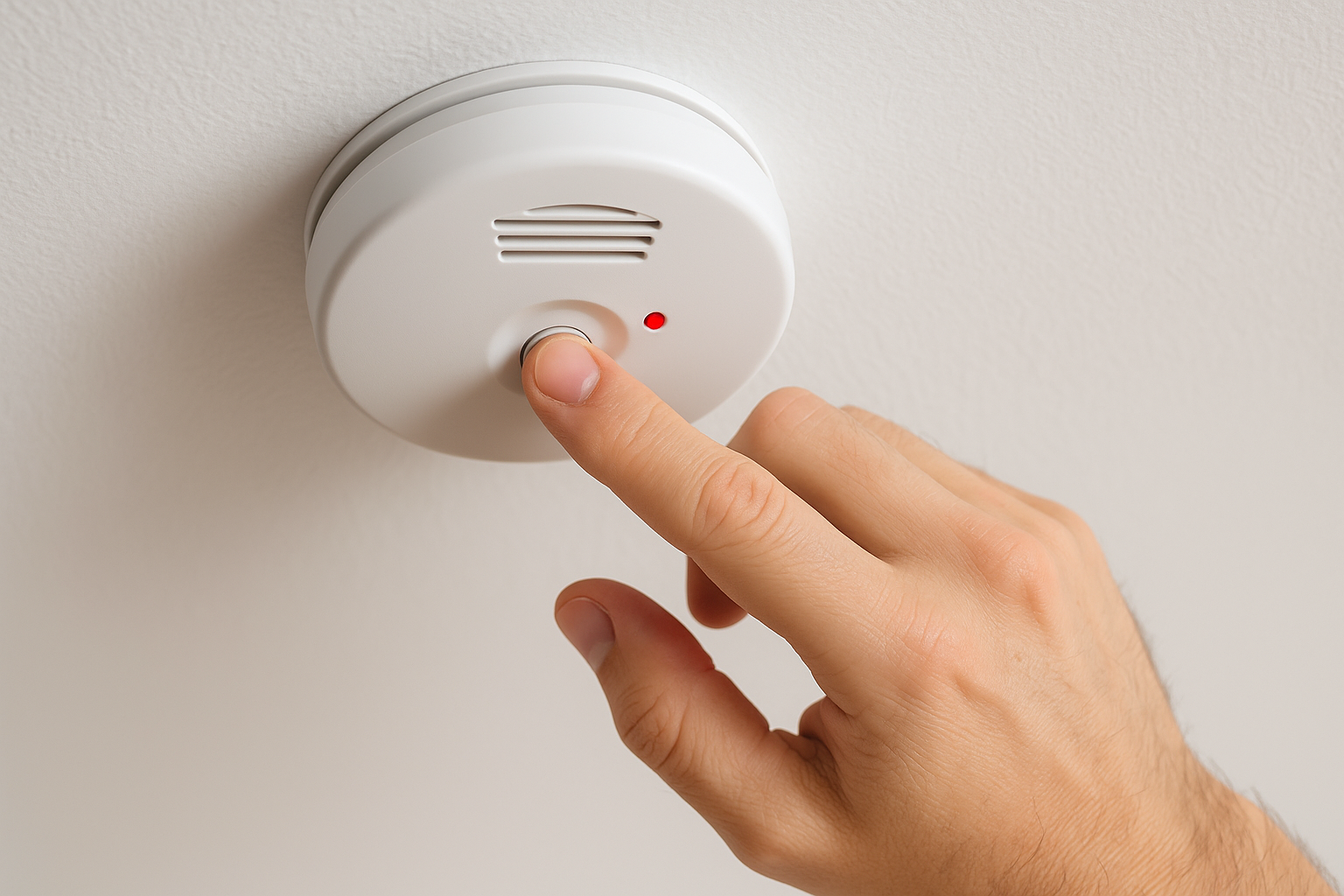Bottom line: Working smoke alarms are not optional in Virginia rentals. Locations are set by building code; annual certification is required under the VRLTA; tenants have day-to-day maintenance duties; and CO alarms are required in specific situations (but are a prudent add even when not strictly mandated).
What’s Required Statewide (VRLTA)
Landlord duty (annual certificate). Virginia’s Residential Landlord & Tenant Act (VRLTA) REQUIRES the landlord to give the tenant a certificate once every 12 months stating that all smoke alarms in the dwelling are present, inspected, and in good working order. The inspection can be done by the landlord, staff, or a contractor.
Replacement. Even if a device “works,” industry standards and most local fire departments advise replacing alarms every 10 years (sooner if malfunctioning).
Tenant duty (maintenance between inspections). Tenants must maintain installed smoke alarms and must not remove or tamper with them.
Where Smoke Alarms Must Be Located (Building Code)
Virginia’s Uniform Statewide Building Code (2021 VRC §R314.3) requires smoke alarms in:
Each sleeping room,
Outside each separate sleeping area,
On every level of the dwelling, including basements and habitable attics, and
Not less than 3 feet horizontally from the door or opening of a bathroom that contains a bathtub or shower unless this would prevent placement of a smoke alarm required by this section.
Interconnection and power source depend on construction/rehab specifics; existing homes commonly comply with listed battery-powered units where rewiring isn’t triggered, while new work follows current interconnection rules. (Local fire officials can confirm details case-by-case.)
“Grandfathered” Is Not A Get-Out-Of-Alarms Card
Across Virginia, local ordinances adopted under VA Code §15.2-922 often close the gap for older housing and require smoke alarms in specified locations regardless of when the building was constructed.
Myth check: “The house is old, so bedrooms don’t need smoke alarms.”
False. Older rentals may not be excused from having bedroom, hallway, and level-by-level alarms under local ordinances that implement state law.
Carbon-Monoxide (CO) Alarms: When Are They Required?
Building and fire codes often require CO alarms in certain occupancies and conditions, most notably when a dwelling (or apartment building) has fuel-burning appliances or an attached garage. (See Virginia’s adoption referencing IBC §915 in Chapter 9(V) of 13VAC5-63-240). Locations are near sleeping areas and on each level per code/standard.
By statute on tenant request. Separate from the code triggers, the VRLTA says that if a tenant sends a written request, the landlord must install a CO alarm within 90 days and may charge a reasonable installation fee. The device must meet USBC standards.
Practical guidance. National authorities (e.g., NFPA) recommend CO alarms near every sleeping area and on each level of the home. Given the low cost, adding CO alarms in rental homes is prudent risk management even when not strictly mandated.
Short Primer on Types of Alarms
Virginia law and building code draw a clear line between alarms and detectors:
Smoke alarms (UL 217). These are the standalone, round devices mounted in bedrooms, hallways, and on each level. They sense smoke and sound an audible warning. These are what the VRLTA annual certificate covers.
Smoke detectors (UL 268). These are system devices tied into a central fire alarm panel (common in apartments or commercial systems). Unless your rental uses a full alarm system, you’re dealing with “alarms,” not “detectors.”
CO alarms (UL 2034). These standalone devices sense carbon monoxide and sound locally. They may be separate or combined with smoke alarms.
CO detectors (UL 2075). These are system-connected, not typical for single-family rentals.
Technology types:
Ionization alarms are faster to flaming fires but prone to nuisance alarms near kitchens.
Photoelectric alarms respond more quickly to smoldering fires and can be closer to kitchens.
Combination alarms often provide the best coverage. Virginia allows any listed type, but the 2021 code includes distance rules (e.g., ionization alarms should be ≥20 ft from kitchens unless nuisance-resistant, photoelectric ≥6 ft).
Power Sources: Hardwired vs. Battery
Owners often ask whether older homes with battery-only alarms must now be rewired. The short answer is no, not always.
Existing, working battery-only alarms: These can remain in place. When you replace them voluntarily, use UL-listed 10-year sealed battery units.
When an alarm fails or becomes defective: Virginia’s code requires it be replaced with either a hardwired unit that includes battery backup (where commercial power is available) or an approved equivalent, such as a 10-year sealed battery alarm.
New construction or substantial renovation: Here, the rules are stricter: new alarms must be hardwired, interconnected, and have battery backup.
Who Does What: At A Glance
Owner/Agent (statewide, plus local overlay):
Install required smoke alarms in every bedrooms, outside sleeping areas, and each level.
Annually provide the smoke-alarm certificate to the resident. Keep copies.
Install CO alarm within 90 days of any tenant’s written request (reasonable fee allowed).
Follow any local ordinance specifics (many require alarms in older homes “regardless of when constructed” and mirror the annual certification duty).
Resident:
Test and maintain installed smoke alarms between inspections; do not remove or disable them; promptly report issues.
Move-in & Annual Checklist
Confirm alarms at every code location (bedrooms, outside sleeping areas, every level).
Test each unit; replace expired units (10-year sealed models are common).
Issue and file the VRLTA smoke-alarm certificate (move-in and annually).
Add CO alarms near sleeping areas and on each level where code requires, or proactively in all rentals as a best practice.
Ensure tenant education: explain they need to test; how to report problems.
FAQs Owners Often Ask
“Our lease says CO is optional unless the tenant asks. Is that right?”
Yes and no. Statutorily, landlords must install a CO alarm if the tenant sends a written request (90-day deadline). Separately, the building/fire code already requires CO alarms in certain conditions (e.g., fuel-burning appliances or attached garage), regardless of whether a tenant asks.
“Do we really need a smoke alarm in every bedroom of an old house?”
Yes. Local ordinances adopted under state law often require alarms in older dwellings consistent with code locations; in such cases, “grandfathered” doesn’t remove the obligation.
BONUS: Troubleshooting Alarms
Even well-installed alarms can give you trouble. Here are the most common issues and how to resolve them quickly:
1. Chirping or Beeping
Low battery: Most alarms chirp every 30–60 seconds when the battery is dying. Replace with a fresh battery (or the entire unit if it’s a 10-year sealed alarm).
End-of-life warning: If new batteries don’t solve it, the unit itself may be expired (usually after 10 years). Check the manufacturing date on the back.
2. Nuisance Alarms (False Alarms)
Cooking smoke/steam: Ionization alarms are more sensitive to cooking. Replace with a photoelectric alarm if false alarms are frequent near kitchens.
Bathroom steam: Avoid placing alarms too close to bathrooms with showers. Code requires at least 3 feet horizontally away.
Dust or insects: Clean gently with a vacuum brush or compressed air.
3. Alarm Won’t Sound During a Test
Battery not installed correctly (check polarity).
Expired unit: Replace if it’s more than 10 years old.
Dirty sensor: Dust buildup can block sensing; clean as above.
4. Multiple Alarms Going Off Together
Interconnected system: A single trigger (smoke, steam, dust) can set all connected units off. Identify the source alarm and resolve the cause.
Wiring issues: If alarms sound randomly in an interconnected system, an electrician may need to inspect connections.
5. Carbon Monoxide Alarm Alerts
Act immediately: Evacuate, call 911, and have HVAC or gas appliances checked. Never ignore or disable a CO alarm.
Low-level warning vs. full alarm: Some models have separate “warning” chirps for low levels; read the manufacturer’s guide to understand the pattern.
Ready to Take the Risk Off Your Plate?
Smoke and CO alarms are more than just code requirements—they’re your first line of defense against liability and loss. At PMI James River, we handle:
Annual inspections and certifications (required under the VRLTA)
Installation and replacement of code-compliant smoke and CO alarms
Documentation and recordkeeping to protect you in the event of disputes or insurance claims
Don’t risk fines, vacancies, or lawsuits over something as preventable as a non-working alarm.
👉 Schedule your free consultation today and let PMI James River ensure your rentals are safe, compliant, and worry-free.


